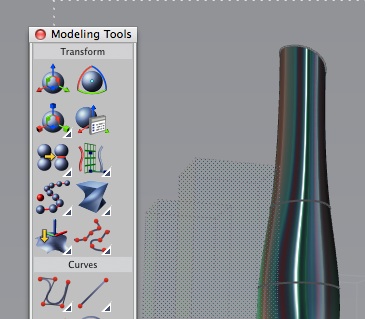Continued from page 2
An Animated Look
There are three key tools for working with the alteration of forms and elements in solidThinking and they are the same core three used in other similar programs as well. They include scale, translate (move) and rotate.
In the original sphere we selected individual points and selected the Translate tool. This tool allows you to move one or more elements along constrained axes. By dragging out a few points on the sphere we turned that form into something more like the nose of an airliner.
The Translate tool is also the tool that automatically pops up when you copy and paste objects, since the copy ends up in the same place as the original, you need to slide it out to see it. This enables you to do direct numerical duplicates placing them a set unit distance from the original across different axes. The third tool, the Rotate tool, was used for the top most elliptical curve to yield the slanted top on the tower forms. With just these three transform tools, two surface modeling tools, two curves tools and some rendered output all of this work has been generated. (see image 14)
In the animation below we demonstrate the use of picking two of the curves in the middle tower. The selection is happening inside the world browser but one could also select the tower itself. However, it is faster in the WB. Watch as the form changes interactively and watch as the metal reflective shader used in this OpenGL view shows the nuances of the form move.
To view the videos full screen you can click on the expand icon lower right corner. To get back to the article hit the escape key on your keyboard.
Final Comments
For several decades now changes in structural engineering approaches and the use of computer-driven manufacturing have more easily enabled implementation of complex surfaces on buildings. The type of tower structures imagined in this article are not terribly different than say what the UK architect, Lord Norman Foster, created at 30 St Mary Axe, “the gherkin” in London. (see image 15 below)

14 – The Gherkin in the UK by Foster and Associates, Architects. (Wikipedia Commons GFDL, 2007)
For skyscraper design in particular it will be interesting to watch where Altair-owned solidThinking Inc., goes in the future, as the company (both solidThinking the subsidiary and Altair Corporation) have made overtures to this market. In fact, Altair has a new focused AEC group.
From talking to the company since last year’s AIA National Convention, we know that the company has been working with AEC giant SOM, utilizing new FEA technology aimed at tall building design in particular. We believe their is ambition to bring some of its expertise in engineering and FEA to the tall structures space. The idea is that architects could model tall building designs of considerable complexity quite quickly and Altair can bring its FEA technologies down to the early stages of design to provide more rapid feedback.
Already the company merges engineering technologies into solidThinking Inspire with its OptiStruct technologies. In the meantime, while all of these possible futures in their tool suite exist, today solidThinking Evolve 2014 provides architects an intriguing and powerful option for advanced curve surfaced building designs. While it is not the only tool in town, as we said in the beginning, it is one tool that the AEC market has only recently begun taking long strolls with.
To learn more about solidThinking Evolve visit here: www.solidthinking.com





Reader Comments
Julia Garden liked this on Facebook.
Peeradon Warithkorasuth liked this on Facebook.
#CAD solidThinking Evolve for Architectural Design Modeling Part 1 http://t.co/vbWwbCX06E
#CAD solidThinking Evolve for Architectural Design Modeling Part 1 http://t.co/vbWwbCX06E
Julia Garden liked this on Facebook.
Julia Garden liked this on Facebook.
Peeradon Warithkorasuth liked this on Facebook.
Want to design a sexy skinned high-rise? Check out this solidThinking article on architectural design.
Want to design a sexy skinned high-rise? Check out this solidThinking article on architectural design.
Comments are closed.